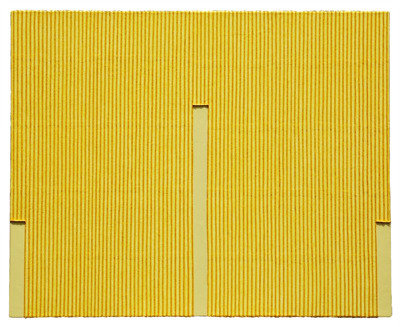Park Seo-Bo
dal 5/11/2014 al 19/12/2014
Segnalato da
5/11/2014
Park Seo-Bo
Galerie Emmanuel Perrotin, Paris
'Ecriture' presents 40 works from the 'ecriture' series, which captures the very essence of park's 60 year long career. Through this repetitive and physical act, Park sought to empty his works of external perception and record his spiritual universe.

Curated by Kim Yongdae
Galerie Perrotin, paris is pleased to present - one of most influent contemporary art movements in asia.
curated by kim yongdae, former director of daegu art museum, the exhibition
presents 40 works from the “ecriture” series, which captures the very essence
of park’s 60 year long career.
The exhibition, on both floors at 76 rue de turenne, reflects the profound
interest in korean painting across the world; interest that has manifested itself
in major exhibitions such as “dansaekhwa: korean monochrome painting” at
the national museum of contemporary art in seoul (2012) and more recently
in rome, new york and los angeles. park seo-bo’s first exhibition in paris
also holds great personal significance for the artist. back in 1961, park came
to paris to participate in "jeunes peintres du monde", the unesco sponsored
competition for young painters, only to realize upon arrival that he had missed
the notification that the competition had been postponed. however, park was
determined to stay in paris, and used the opportunity to see the works of the
great art informel artists, whose work pervaded the parisian art scene at that
time. this one-year experience and his participation in the biennale de paris
in 1963, had a considerable influence on his work as an artist, laying down
the foundations of park’s unique language, which led to the “ecriture” series.
Park began with Art Informel at the end of the 1950s before moving to works
that emphasized expressionistic gesture, such as with the “Primordialis” and
“Hereditarius” series from the early 1960’s. The “Ecriture” series, which Park
refers to as the ‘journey of the hand’, began in the mid 1960’s and signified a
new chapter in his work. In the early “Ecriture” works, Park covered canvases
with light gray or cream-colored oil paints and drew continuous lines with a
pencil on the still-wet surfaces. Through this repetitive and physical act, Park
sought to empty his works of external perception and record his spiritual
universe. In the early 1980's, Park used hanji, traditional Korean paper, to
greater emphasize the virtue of material. He piled layers of wet hanji on the
canvas, saturated the layers with watercolor paints, and then applied strokes
on the paper surface using his fingers or tools, which pushed up the material
creating traces and reliefs. This process generates an energy that permeates
the entire canvas. Later works introduced more vertical structural elements,
and emphasis was placed on a stricter and more understated, meditative
atmosphere. In her essay, Barbara Bloemink emphasizes the works' "three-
dimensionality" when viewed closely and from the side, as the paper is
pushed against the incised lines1. A transition in color was made from his
initial ascetic, neutral achromatic palette to various colors that commune
with nature, where colors are originated. The use of such colors from nature
such as the “color of water”, delivers a subtle and simple flavor, departing
from the artificial palette and giving the works a sense of vitality.
As Barbara Bloemink explains, Park has been viewed by many as a Minimalist;
however, his intentions differ markedly from Western Minimalism in its open
espousal and implementation of Eastern philosophy and sensibilities2. Park’s
works are the result of intense, in-depth thinking and great physical energy,
encouraging the audience to go beyond simple visual assessment in order to
fully understand and experience the works with their minds. This intense and
endless process of emptying himself into his work reflects Park’s belief that
"what is minimal embodies the most", which is also indicative of his notion of
“doing art” as deriving from the discipline of the spirit. In a touching 1994 tribute
to the artist, renowned French art critic Pierre Restany suggested that Yves
Klein and Park Seo-Bo “differ not by nature but by destiny.” Klein’s explosive
energy is, according to Restany, both consumed by and tending towards a
cosmic void. By contrast, Park Seo-Bo is not seen as being driven towards
any kind of telos, instead as existing and wrestling within what Restany calls
"the organic identity of the whole". The distinctive identity of Park Seo-Bo’s
work is that it does not impose itself by claiming a break with the past, or
announcing any promise of future outcome, it is simply occupying the radical
moment of presence.
Image: Park Seo-Bo, No. 070405
Press Contacts:
Thomas Chabaud, Press Officer +33 1 76210711 thomaschabaud@perrotin.com
Opening reception: Thursday, November 6, 4-9pm
76 rue de Turenne - 75003 Paris
10 impasse Saint Claude - 75003 Paris
T: +33 1 42 16 79 79 / F: +33 1 42 16 79 74
Tuesday - Saturday, 11am - 7pm



